
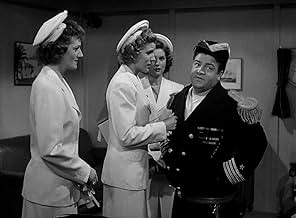
The Andrews Sisters were an American close harmony singing group of the swing and boogie-woogie eras. The group consisted of three sisters: contralto LaVerne Sophia Andrews (1911-1967), soprano Maxene Anglyn Andrews (1916-1995), and mezzo-soprano Patricia Marie Andrews (1918-2013). The sisters have sold an estimated 80 million records. Their 1941 hit "Boogie Woogie Bugle Boy" can be considered an early example of jump blues. Other songs closely associated with the Andrews Sisters include their first major hit, "Bei Mir Bist Du Schon (Means That You're Grand)" (1937), "Beer Barrel Polka (Roll Out the Barrel)" (1939), "Beat Me Daddy, Eight to the Bar" (1940), "Don't Sit Under the Apple Tree (with Anyone Else but Me)" (1942), and "Rum and Coca-Cola" (1945), which helped introduce American audiences to calypso.
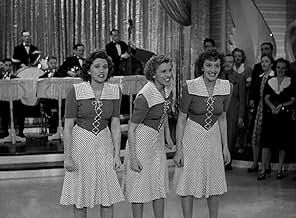
The Andrews Sisters' harmonies and songs are still influential today and have been copied and recorded by entertainers such as Patti Page, Bette Midler, Christina Aguilera, Pentatonix, and others. The group was among the inaugural inductees to the Vocal Group Hall of Fame upon its opening in 1998. Writing for Bloomberg, Mark Schoifet said the sisters became the most popular female vocal group of the first half of the 20th century. They are still widely acclaimed today for their famous close harmonies. They were inducted into the Minnesota Rock/Country Hall of Fame in May 2006.
The sisters were born to Olga Bergliot "Ollie" (nee Sollie; 1886-1948) and Peter Andreas. Peter Andreas (later "Andrews"), (1890-1949) was Greek and his wife Olga Andrews was of Norwegian ancestry raised in the Lutheran faith. The Sollie family disapproved of Olga's marriage, but the relationship was repaired once their first child, LaVerne, was born July 6, 1911. Their second daughter, Anglyn, died at eight months of age on March 16, 1914. Maxene arrived on January 3, 1916, and Patty was born February 16, 1918.
Patty, the lead singer of the group, was 7 when the trio was formed, and 12 when they won first prize at a talent contest at the local Orpheum Theatre in Minneapolis, where LaVerne played piano accompaniment for the silent film showings in exchange for dancing lessons for her and her sisters. Following the collapse of their father's Minneapolis restaurant, the sisters went on the road to support the family. All three attended Franklin Junior High School and North High School, both in Minneapolis.
They started their career as imitators of an earlier successful singing group, the Boswell Sisters, who had been popular until their breakup in 1936. After singing with various dance bands and touring in vaudeville with Leon Belasco (and his orchestra) and comic bandleader Larry Rich, they first came to national attention with their recordings and radio broadcasts in 1937, most notably via their major Decca record hit, "Bei Mir Bist Du Schon" (translation: "To Me, You Are Beautiful"), originally a Yiddish tune, the lyrics of which Sammy Cahn had translated to English and "which the girls harmonized to perfection." They followed this success with a string of best-selling records over the next two years and, by the 1940s, had become a household name.
Instrumental to the sisters' success over the years were their parents, Olga and Peter, their orchestra leader and musical arranger, Vic Schoen (1916-2000), and Jack and David Kapp, who founded Decca Records. In the years just before and during World War II, the Andrews Sisters were at the height of their popularity, and the group still tends to be associated in the public's mind with the war years. They had numerous hit records during these years, both on their own and in collaboration with fellow Decca Records artist Bing Crosby. Some of these hits had service or military related themes, including "Boogie Woogie Bugle Boy", "Three Little Sisters", "Don't Sit Under the Apple Tree (with Anyone Else but Me)", "A Hot Time In the Town of Berlin" and "Rum and Coca-Cola". The sisters performed their hits in service comedy films, such as Buck Privates and Private Buckaroo.
During the war, they entertained the Allied forces extensively in Africa and Italy, as well as in the U.S., visiting Army, Navy, Marine, and Coast Guard bases, war zones, hospitals, and munitions factories. They encouraged U.S. citizens to purchase war bonds with their rendition of Irving Berlin's song "Any Bonds Today?". They also helped actress Bette Davis and actor John Garfield found California's famous Hollywood Canteen, a welcome retreat for servicemen where the trio often performed, volunteering their personal time to sing and dance for the soldiers, sailors, and Marines (they did the same at New York City's Stage Door Canteen during the war).
While touring, they often treated three random servicemen to dinner when they were dining out. They recorded a series of Victory Discs (V-Discs) for distribution to Allied fighting forces only, again volunteering their time for studio sessions for the Music Branch, Special Service Division, of the Army Service Forces, and they were dubbed the "Sweethearts of the Armed Forces Radio Service" for their many appearances on shows such as "Command Performance", "Mail Call", and "G.I. Journal."
The sisters' 1945 hit "Rum and Coca-Cola" became one of their most popular and best-known recordings, but also inspired some controversy. Some radio stations were reluctant to play the record because it mentioned a commercial product by name, and because the lyrics were subtly suggestive of local women prostituting themselves to U.S. servicemen serving at the naval base on Trinidad. The song was based on a Trinidadian calypso, and a dispute over its provenance led to a well-publicized court case. The sisters later told biographers that they were asked to record the tune on short notice and were unaware either of the copyright issue or of the implications of the lyrics.
An ad in the 1951 'Radio Annual' showed photos of the Andrews as children, as contemporary singers, and as old women in the then-future year of 1975, although the act would not make it that long. In the 1950s, Patty Andrews decided to break away from the act to be a soloist. She had married the trio's pianist, Walter Weschler, who became the group's manager and demanded more money for Patty. When Maxene and LaVerne learned of Patty's decision from newspaper gossip columns rather than from their own sister, it caused a bitter two-year separation, especially when Patty sued LaVerne for a larger share of their parents' estate. Patty attributed the breakup to the deaths of their parents: "We had been together nearly all our lives," Patty explained in 1971. "Then in one year our dream world ended. Our mother died (in 1948) and then our father (in 1949). All three of us were upset, and we were at each other's throats all the time." In 1951, they recorded "The Windmill Song" which is an adaptation of the French song "Maitre Pierre" written in 1948 by Henri Betti (music) and Jacques Plante (lyrics). The English lyrics were written by Mitchell Parish. The Andrews Sisters formally broke up in 1953.
Maxene and LaVerne tried to continue the act as a duo and met with good press during a 10-day tour of Australia, but a reported suicide attempt by Maxene in December 1954 put a halt to any further tours (Maxene spent a short time in the hospital after swallowing 18 sleeping pills, an occurrence that LaVerne told reporters was an accident). Maxene and LaVerne did appear together on The Red Skelton Show on October 26, 1954, singing the humorous "Why Do They Give the Solos to Patty" as well as lip-synching "Beer Barrel Polka" with Skelton in drag filling in for Patty. This however did not sit well with Patty, and a cease-and-desist order was sent to Skelton. The sisters' private relationship was often troubled, and Patty blamed it on Maxene: "Ever since I was born, Maxene has been a problem, and that problem hasn't stopped," she said.
The trio reunited in 1956 and signed a new recording deal with Capitol Records, for whom Patty was already a featured soloist. By this point, however, rock-and-roll and doo-wop were dominating the charts, and older artists were left by the wayside. The sisters recorded a dozen singles through 1959, some of which attempted to keep up with the times by incorporating rock sounds. None of these achieved any major success. In addition, they produced three hi-fi albums, including a vibrant LP of songs from the dancing 1920s with Billy May's orchestra. In 1962, they signed with Dot Records and recorded a series of stereo albums until 1967, both re-recordings of earlier hits which incorporated up-to-date production techniques as well as new material, including "I Left My Heart in San Francisco", "Still", "The End of the World", "Puff the Magic Dragon", "Sailor", "Satin Doll", "Mr. Bass Man", the theme from Come September, and the theme from A Man and a Woman. They toured extensively during the 1960s, favoring top nightclubs in Las Vegas, California, and London, England.
Eldest sister LaVerne died in 1967 at the age of 55 after a year-long bout with cancer, during which she was replaced by singer Joyce DeYoung (May 24, 1926 - March 7, 2014). DeYoung fulfilled concert appearances, including an appearance on The Dean Martin Show on November 30, 1967, but she did not record with Patty and Maxene. LaVerne had founded the original group and often acted as the peacemaker among the three during the sisters' lives, more often siding with her parents, to whom the girls were extremely devoted, than with either of her sisters. Their last appearance together as a trio was on The Dean Martin Show on September 29, 1966.
After LaVerne died, Maxene and Patty continued to perform periodically until 1968, when Maxene became the Dean of Women at Tahoe Paradise College, teaching acting, drama, and speech, and working with troubled teens; and Patty was once again eager to be a soloist.
In 1969, Patty appeared in Lucille Ball's third series Here's Lucy, in the sixth episode of the second season, titled "Lucy and the Andrews Sisters". The episode has Patty enlisting the help of Lucy, her daughter Kim (played by Lucie Arnaz), and her son Craig (Desi Arnaz Jr.) to perform a medley of Andrews Sisters hits for the Andrews Sisters Fan Club reunion. Lucy played LaVerne, Kim (Lucie Arnaz) played Maxene, and Craig (Desi Arnaz Jr.) played Bing Crosby. She also had a cameo as herself along with many other stars in the 1970 film The Phynx.
Patty and Maxene's careers experienced a resurgence when Bette Midler covered "Boogie Woogie Bugle Boy" in 1973. The next year, the pair debuted on Broadway in the Sherman Brothers' nostalgic World War II musical: Over Here!, which premiered at the Shubert Theatre to rave reviews. This was a follow-up to Patty's success in Victory Canteen, a 1971 California revue. Over Here! starred Maxene and Patty (with Janie Sell filling in for LaVerne and winning a Tony Award for her performance) and was written with both sisters in mind for the leads. It launched the careers of many now notable theater, film, and television stars, including John Travolta, Marilu Henner, Treat Williams, and Ann Reinking. It was the last major tour for the sisters and was cut short owing to a conflict with the show's producers over pay for the sisters, resulting in the cancellation of an extensively scheduled road tour. Over Here! lasted only a year, and its end marked the last time the sisters would ever sing together.
Patty continually distanced herself from Maxene, until her death, and would not explain her motives regarding the separation. Maxene appealed to Patty for a reunion, personally if not professionally, both in public and in private, but to no avail. Maxene suffered a serious heart attack while performing in Illinois in 1982 and underwent quadruple bypass surgery, from which she successfully recovered. Patty visited her sister while she was hospitalized. Now sometimes appearing as "Patti" (but still signing autographs as "Patty"), she re-emerged in the late 1970s as a regular panelist on The Gong Show. Maxene had a successful comeback as a cabaret soloist in 1979 and toured worldwide for the next 15 years, recording a solo album in 1985 entitled "Maxene: An Andrews Sister" for Bainbridge Records. Patty started her own solo act in 1980 but did not receive the critical acclaim her sister had for her performances, even though Patty was considered to be the "star" of the group for years. The critics' major complaint was that Patty's show concentrated too much on Andrews Sisters material, which did not allow Patty's own talents as an expressive and bluesy vocalist to shine through.m
The two sisters did reunite, albeit briefly, on October 1, 1987, when they received a star on Hollywood's Walk of Fame, even singing a few bars of "Beer Barrel Polka" for the Entertainment Tonight cameras. The 1987 Whittier Narrows earthquake had shaken the area that morning and the ceremony was nearly cancelled, which caused Patty to joke, "Some people said that earthquake this morning was LaVerne because she couldn't be here, but really it was just Maxene and me on the telephone." Besides this, and a few brief private encounters, they remained somewhat estranged for their remaining years, with Maxene dying in 1995.
Shortly after her Off-Broadway debut in New York City in a show called Swingtime Canteen, Maxene suffered another heart attack and died at Cape Cod Hospital on October 21, 1995, making Patty the last surviving Andrews Sister. Not long before she died, Maxene told music historian William Ruhlmann: I have nothing to regret. We got on the carousel and we each got the ring and I was satisfied with that. There's nothing I would do to change things if I could...Yes, I would. I wish I had the ability and the power to bridge the gap between my relationship with my sister, Patty.
Upon hearing the news of her sister's death, Patty became distraught. Several days later, Patty's husband Wally fell down a flight of stairs and broke both wrists. Patty did not attend her sister's memorial services in New York City, nor in California. Bob Hope said of Maxene's death, "She was more than part of The Andrews Sisters, much more than a singer. She was a warm and wonderful lady who shared her talent and wisdom with others.". LaVerne Andrews married Lou Rogers, a trumpet player in Vic Schoen's band, in 1948. The two remained together until LaVerne's death from liver cancer on May 8, 1967, at the age of 55. Lou died in 1995.
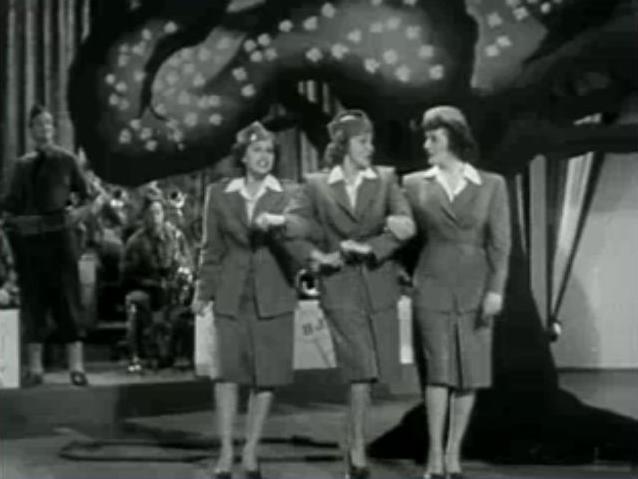
Maxene Andrews married music publisher Lou Levy in 1941, separating in 1949. They adopted a girl and a boy, Aleda Ann and Peter. Levy was the sisters' manager from 1937 to 1951. Later in life, according to her adopted daughter, Maxene entered a thirteen-year relationship with her manager Lynda Wells and they later spent many years as life partners. "To me, being gay was not a central focus of Maxene's life at all," Wells told radio station The Current (KCMP) in a 2019 interview. "Her art was. Her singing was." But Wells says that their status as companions, and Maxene's health issues as she got older, led Maxene to adopt her as a daughter. "There was no such thing as being married at that time," she said. "During her lifetime, there was no such thing that existed for us." Maxene died October 21, 1995, at age 79. The ashes of LaVerne and Maxene Andrews are interred in the Columbarium of Memory of the Forest Lawn Memorial Park Cemetery in Glendale, California, close to the ashes of their parents.
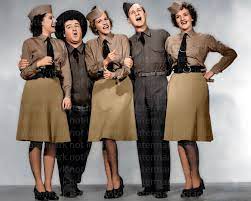
Patty Andrews married agent Marty Melcher in 1947 but left him in 1949, when he pursued a romantic relationship with Doris Day. She then married Walter Weschler, the trio's pianist, in 1951. Patty died of natural causes at her home in Northridge, California, on January 30, 2013, at the age of 94. Weschler, her husband of nearly 60 years, had died on August 28, 2010, at the age of 88. Joyce DeYoung Murray, who replaced LaVerne from late 1966 to 1968, died in March 2014 at the age of 87.
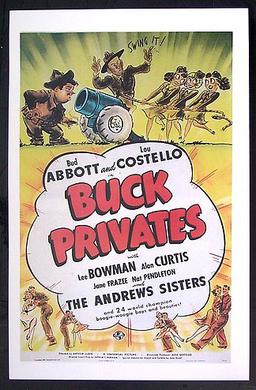
Buck Privates is a 1941 American musical military comedy film directed by Arthur Lubin that turned Bud Abbott and Lou Costello into bona fide movie stars. It was the first service comedy based on the peacetime draft of 1940. The comedy team made two more service comedies before the United States entered the war (In the Navy and Keep 'Em Flying). A sequel to this movie, Buck Privates Come Home, was released in 1947. Buck Privates is one of three Abbott and Costello films featuring The Andrews Sisters, who were also under contract to Universal Pictures at the time.